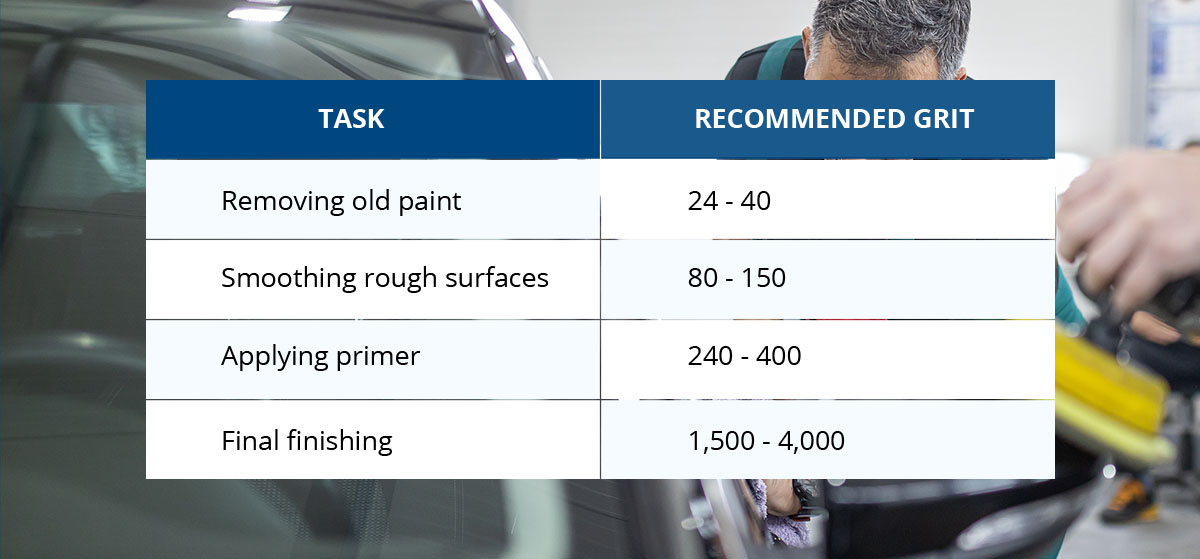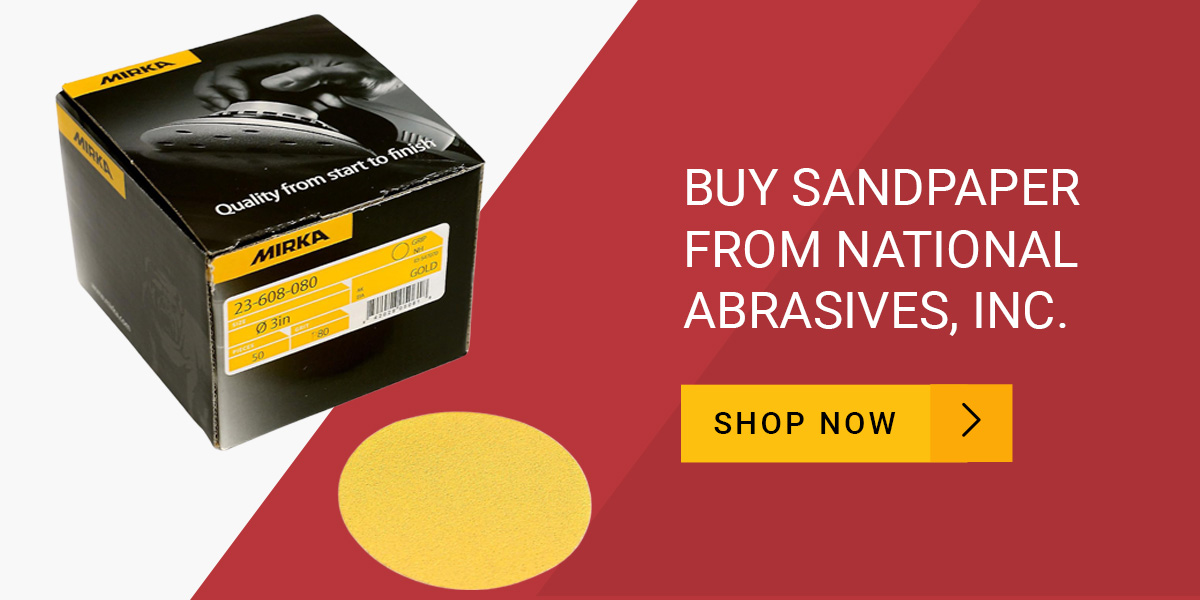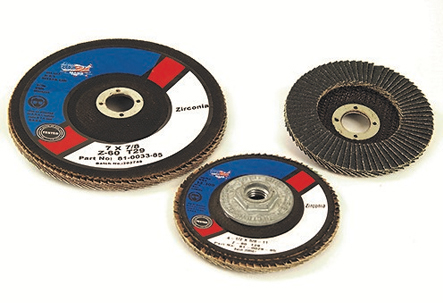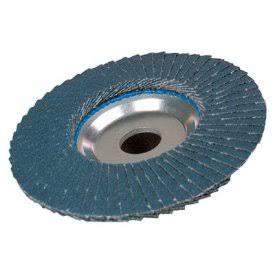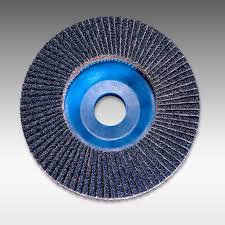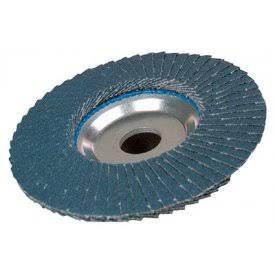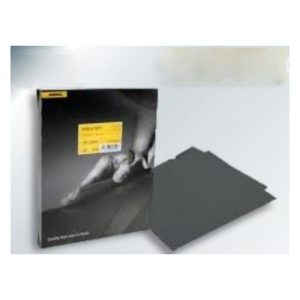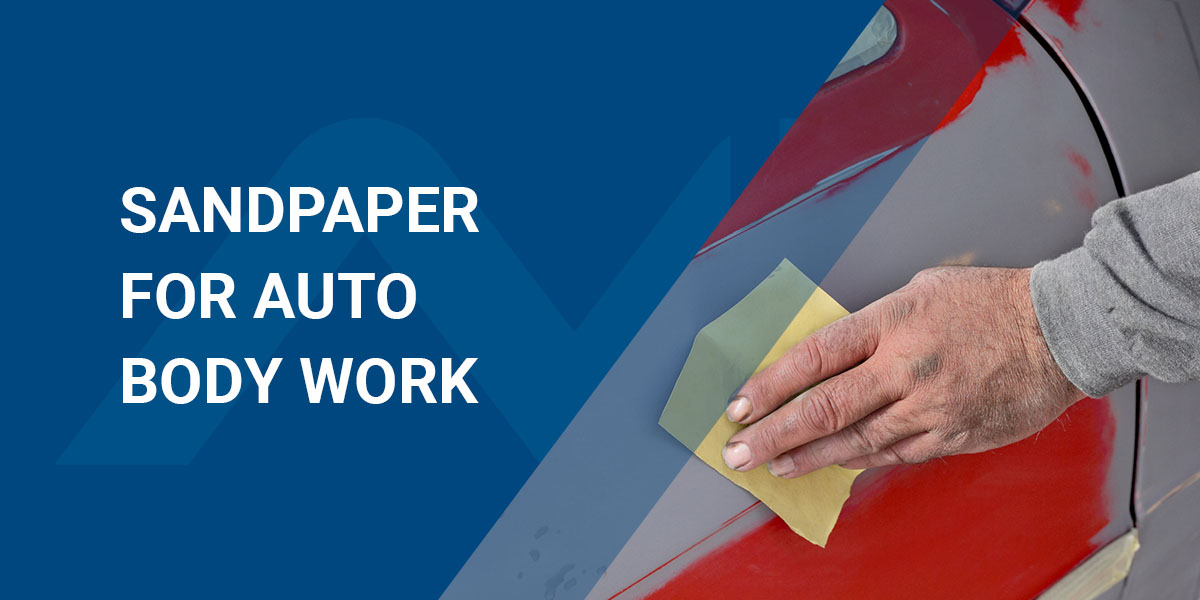
When it’s time to repaint a car, the task is more complex than just applying a new coat above the older paint job. In most cases, it’s best to remove the paint currently on the vehicle and start afresh.
Therefore, any car owner considering a new paint job should understand the various grit intensities on the automotive sandpaper grit chart. Whether you plan on doing it yourself or bringing your vehicle to a professional, knowing the standard autobody grits can help you determine exactly what your car needs. Check out one of our top-selling foam grip discs, perfect for automotive sanding!
What Grit Sandpaper to Use for Car Paint?
Use coarse sandpaper of 24- to 40-grit to remove old paint, 150-grit to smooth out the scratches, 240- to 400-grit for wet sanding primer and 1,500- to 4,000-grit for smooth finishing. If it’s a new car with a single coat of paint, start with the 150-grit sandpaper, as it’s the best option for stripping off single layers of paint.
| Task | Recommended Grit |
|---|---|
| Removing old paint | 24-40 |
| Smoothing rough surfaces | 80-150 |
| Applying primer | 240-400 |
| Final finishing | 1,500-4,000 |
Guide to Sanding a Car Before Painting
How do you sand a car for painting? What sandpaper grit is right for a primer before painting a car? If you have these questions, here is a brief step-by-step grit recommendation for every stage of the process:
- Step 1: This stage involves heavy paint removal. You can skip it if you’re dealing with a single-coat layer, as it will be too aggressive. Use 24- to 40-grit coarse sandpaper. To shape reinforced body fillers, use 40-grit sandpaper.
- Step 2: Use the 80- to 150-grit for light paint removal, shaping body filler and polishing the metal before applying primer.
- Step 3: Use 180-grit to smooth out scratches, straighten the body filler and eliminate defects.
- Step 4: The 320 to 400 grit range is excellent at this final stage before primer. The finer grit provides reliable sanding as a pre-primer prep.
- Step 5: The final sanding before applying paint requires a 600- to 800-grit range to sand imperfections and polish the surface for paint application.
- Step 6: Use 1,500- to 4,000-ultra-fine grit for wet sanding imperfections and polishing the surface after a clear coat.
Flap Disc Sandpaper Grit Chart for Auto Body Work
Flap discs are grinding wheels that use layered flaps of coated abrasive to sand down surfaces. They’re great tools for removing rust and polishing and shaping metal. They’re different from flap wheels, which are meant for harder-to-access areas like the insides of pipes or tubes. Visually, the difference is obvious — the flaps on flap discs face downwards, while those on a flap wheel face directly outward.
Here are a few of the benefits of using flap discs for your project:
- Versatile: Flap discs can perform well, even on bumpy or uneven surfaces.
- Cooler functioning temperature: They produce less heat than other abrasive tools, which reduces the risk of leaving behind scorch marks.
- Lower vibration: Because they vibrate less than grinding wheels, flap discs generate less noise and allow for more comfortable operation.
- Exceptional results: Flap discs provide a better overall finish with less gouging than other mechanical abrasive tools.
Flap discs come in several different materials:
- Zirc
- Zirconium
- Ceramic
- Aluminum oxide
The chart below breaks down each grit of flap disc available from National Abrasives, Inc.:
Grit Breakdown: Which Sandpaper Is Right for Your Project?
In automotive bodywork and other painted metal applications, it’s crucial to select the proper sandpaper grit sizes because the varying degrees of textures impact the final results. When removing paint or rust, you need a coarse grit but the resulting rough surfaces will need finer grits for smoothing.
While the grit range varies depending on the sanding application, in most instances, you move from coarser grits to finer ones, scrapping off old coatings and polishing new ones.
You can tell the coarseness of a sandpaper’s grit by checking its number. Lower numbers indicate a coarser grit, while higher numbers indicate finer grits. Here, we’ll explain which grit is right for each stage of a paint job and why.
Extra Coarse: 24-Grit to 36-Grit
Aside from grinding discs, sandpapers in the 24 to 36 range are the roughest of all grits. Typically, you’d use a grit of this intensity in projects with rough edges forming along a panel.
For instance, if a car has been grazed along the side by a tree, a 24-grit piece of sandpaper could help even out the roughness. However, sandpapers in this range can be too aggressive for smooth surfaces, leaving scratch marks. It’s best to reserve high-intensity grits for surfaces that demand heavy sanding to even out.
Sandpaper in the 24 to 36-grit range is most appropriate for projects where the automobile has rough surface areas that need flattening. For example, older cars that have seen numerous overcoats with worn layers can have inconsistent surfaces. Not only will the car be tough to sand down to its metal, but there will also be certain spots that need more intense sanding than other spots. This is when grits in the 30s range are most useful.
Once you’ve stripped the caked-on paint with a 24- or 36-grit sandpaper, you’ll need to smooth out those areas with a higher-grit, less intense sandpaper. Remember, auto-sanding projects of this intensity are not the norm. Therefore, if you’re wondering what grit sandpaper to use for a car, the answer in most cases would be somewhere above this grit range.
Pro Tip: If you’re sanding by hand, make sure to use a sanding block. Your hand places uneven pressure on the sheet, which can cause imperfections in the car’s surface. Wrapping a piece of sandpaper around a sanding block helps to provide even pressure along the length of the sheet — the difference in sanding quality will be immediately noticeable.
Sandpaper Sheets for Auto Work:
- Waterproof Sanding Sheets
- Abranet Sanding Sheets
- Goldflex Sanding Sheets
- Bulldog Gold Sanding Sheets
Coarse: 40-Grit
The minor differences between 30- and 40-grit sandpapers mean that their large grains can leave rough streaks on painted metals. Similar to 30-grit sandpapers, 40-grit sandpapers are most suitable for high-intensity sanding.
On the automotive sandpaper grit chart, 40-grit is generally recommended for cars, trucks and vans that have had several overlying paint jobs over the years. Alternately, 40-grit sandpaper can be useful along spots of a vehicle where the surface has been grazed by falling objects, in which case a touch-up might ultimately be necessary.
Another use for 40-grit sandpaper is rust removal. Even though rusting doesn’t occur on all vehicles, cars parked outdoors in times of rain, snow and hail are sometimes vulnerable, especially when moisture makes its way through cracks in the paint. Since rust devastates metal surfaces, you want to stop it as soon as it forms on the vehicle’s panel. If left unaddressed, rust can eat holes through the vehicle’s body, ultimately leading to costly repairs.
You can rub away with 40-grit sandpaper before it spreads. Afterward, you’ll want to smooth out the affected area with a higher-grit sandpaper and then seal off the spot with a paint touch-up.
Pro Tip: You should always take precautions to prevent injury when stripping paint from your car, especially if you plan to use chemical treatments. When you begin the paint stripping process, you should wear long, thick clothing made of fabrics like denim. Additionally, a mask and a pair of heavy-duty work gloves are essential for any project.
Medium: 80-Grit
Unlike the 30- and 40-grit ranges, 80-grit sandpaper is gentler on vehicle surfaces and doesn’t leave rough streaks, making it ideal for sanding roof, hood and door panels.
However, light streaking will still be present if you apply heavy force. When using an 80-grit sandpaper on a vehicle, it’s best to follow it up with a higher-grit sandpaper for smoothening. Ultimately, 80-grit is best used on vehicles that need considerable sanding in select areas but without the roughness of lower-grit options.
An 80-grit piece of sandpaper could be most useful on cars with more than one prior paint job and vehicles with light corrosion around the edges. For example, a car with a five-year-old paint job over an earlier initial coat of paint might be difficult to sand with higher-grit sandpaper. On the other hand, 80-grit could more easily work through the layers of paint and primer to reveal the metal surface.
Likewise, you can easily sand off light rust along the lower edges of the doors with 80-grit sandpaper.
While 80-grit sandpaper isn’t ideal for a newer vehicle with a single, even coat of paint, it’s advisable for vehicles that need intense sanding without the aggressiveness of low-grit sandpaper.
Shop 80G Abrasive Discs Online
Sandpaper Sheets for Auto Work:
- Waterproof Sanding Sheets
- Abranet Sanding Sheets
- Goldflex Sanding Sheets
- Bulldog Gold Sanding Sheets
Fine: 150-Grit
The automotive sandpaper grit chart gets smoother with 150-grit, which leaves fine sanding marks on painted metals. However, 150-grit lacks the intensity needed to smooth out nicks and strip away multiple layers of paint. In fact, a 150-grit sandpaper is mostly used for feathering areas that have already been sanded with a lower-intensity grit.
For example, when the rusted portion of an auto-body panel has been sanded with a 32- or 40-grit piece of sandpaper, 150-grit is an ideal option for smoothing out the rough grooves that might exist at certain spots.
On cars with a smooth, single layer of paint, 150-grit sandpaper can adequately strip the paint to reveal the metal surface. In some cases, there might be little, if any, need for smoothing out rough grains with a lower-intensity sandpaper. On panels that only need touching up in a certain spot, 150-grit will often be the perfect choice for smoothing out the edges of the crack or chip in an otherwise good coat of paint.
When people ask about what grit sandpaper to use when painting a car, 150-grit is one of the more popular recommendations. Consider using a palm sander with 150-grit sandpaper to reduce the manual effort.
Get 150G Waterproof Sanding Sheets
Very Fine: 240-Grit
When you reach the 200 range, sandpaper becomes smoother yet stronger than any lower-grit option. You can use 240-grit sandpaper to easily strip an automobile panel of all paint. The sanding can be accomplished without the blunt streaks that a 32-grit would leave in its path. As such, 240-grit is the first level of sandpaper to consider for a car, truck or van with a smooth yet thick paint job without corrosion or damage.
Even if your car has a second paint job over the first, it’s fairly easy to strip away the paint and reveal the metal with 240-grit.
Vehicles built within the past three or four years likely have only had one paint job. Due to the car’s relatively young age, the paint is unlikely to have cracked in any spots, and rust has not had the chance to take root anywhere. Therefore, you can easily strip the panels to the bare metal with a 240-grit piece of sandpaper, and all with little or no need for secondary grit.
When people ask what grit of sandpaper is suitable for a wet sanding primer, 240-grit is a popular answer because a wet, folded 240 will generally offer durability during a sanding job.
Buy 240G Waterproof Sanding Sheets
Extra Fine: 320-Grit
At this point along the wet sandpaper grit chart, the options are ideal for smooth buffering as well as the removal of thick paint. With a 320-grit piece of sandpaper, paint should come off the vehicle with evenly applied strokes of a disc. By the time you work a 320-grit through the paint, the shiny, silvery luster of the metal should come glaring to the surface. Thanks to the strength of 320-grit sandpaper, it’s a good option for cars or vans that have been treated with enamel or other hard coats.
A perfect example of how 320-grit sandpaper can work is when you want to turn a blue van red. Before you apply the new paint job, you’ll want to sand away the older blue coats. With 320-grit, the blue should come off smoothly and easily. Once all of the panels have been stripped, the surfaces should be smooth enough for a primer coat of the new paint.
Alternately, 320-grit could make it really easy to change out the paint on a single panel, such as a scratched door. As such, when people ask what grit sandpaper to use when painting a car, 320-grit is a good choice for large automobiles with thick coats of paint.
Super Fine: 400-Grit
When it comes to finishing, the most popular option is 400-grit sandpaper. Before the new coat of paint is applied, 400-grit paper makes prepping smooth and easy. If there are any rough areas spotted along the surface or edges of a given panel, 400-grit could be used to smooth the metal out in a way that lower grits might be incapable of.
The best thing about 400-grit sandpaper is that, despite its strength, it’s fine enough to handle challenges along an auto-body surface without roughing up the metal.
When the question arises about what grit sandpaper is appropriate for a wet sanding primer, 400-grit is sometimes stressed as better for wet sanding than for dry sanding. The reasoning here is that, when dry, 400-grit tends to leave sand on the subject, which can be troublesome as far as finishing work is concerned. Therefore, while 400-grit is one of the most popular grits of sandpaper, it’s often used exclusively for wet sanding. As such, 400-grit is one of the most widespread options on the wet sandpaper grit chart.
Pro Tip: When you move up to higher-grit sandpaper, a great way to check your work is to run your hand along the surface of the vehicle and feel for imperfections. Your hand should be able to pick up tiny flaws that aren’t otherwise perceptible.
Super Fine: 600-Grit
When it comes to correcting errors in soft layers of paint, 600-grit sandpaper makes the task relatively easy. Likewise, if paint runs out before a panel has been fully covered, the edges of the paint can be sanded smooth with a wet 600.
Basically, a 600-grit sandpaper is a perfect option when you need to salvage the panels after a paint job has hit a snag. Considering all the time and money that can slip down the drain when a vehicle-painting project doesn’t go as planned, 600-grit sandpaper is a lifesaver because it reduces complications.
For example, you might be painting a car with a unique color that has to be specially ordered, but end up with a bad passenger door or roof due to the paint running out when you’re 93% finished. Under other circumstances, you might have needed to do the paint job over again, yet still be at risk of running out along another part of the vehicle.
With 600-grit sandpaper, it needn’t be as costly or time-consuming, because the raw edges of an unfinished paint job can be sanded back for a recoat and will therefore be ready by the time a new supply of the same paint arrives.
Sandpaper Sheets for Auto Work:
- Waterproof Sanding Sheets
- Abranet Sanding Sheets
- Goldflex Sanding Sheets
- Bulldog Gold Sanding Sheets
Ultra Fine: 1,500-Grit to 4,000-Grit
For color sanding and buffing, sanding discs in the 1,500 to 4,000 range are ideal options.
Once a new coat of paint has been applied to a vehicle and given time to dry, a sandpaper disc in this range allows for a smooth and even finishing touch along areas of panels that might exhibit roughness or inconsistencies along the painted surfaces. That way, you won’t experience any significant setbacks if minor challenges occur, such as the discovery that dirt or hairs have been stuck to the surface under the paint.
The benefits of 1,500- and 4,000-grit sandpaper discs make it especially easy to paint larger automobiles. In the past, sanding down a van could take an entire day, if not longer. Likewise, redoing a door or hood on which dirt landed as the paint was drying could lead to further loss of money and hours.
Today, electric random orbital sanders make it possible to sand a van or a truck in a matter of hours, while mistakes can easily be eliminated in minutes with 1,500- or 4,000-grit sandpaper.
Pro Tip: When you’re sanding with grits 1,500 and above, you need to use a wet sanding technique to ensure good results. Whether you use water or a detergent, the liquid will act as a lubricant for the sandpaper, removing tiny particles as you sand to prevent the paper from getting clogged.
Shop 1500 & 4000G Sanding Discs
Buy Sandpaper From National Abrasives, Inc.
When it comes to sanding systems, Mirka is one of the world’s leading providers. Mirka’s products make it easier to refurbish older vehicles and make the exteriors shiny and new thanks to their commitment to automotive refinishing and closely related technologies.
As one of the leading suppliers of Mirka products, National Abrasives, Inc. is proud to be a convenient, one-stop source for a full range of sanders, accessories and other tools. With our secure, 24/7 ordering process, we offer free shipping on bulk orders, as well as price matching for anything you find in our inventory.
To learn more about what we have to offer, visit our sales pages today!

